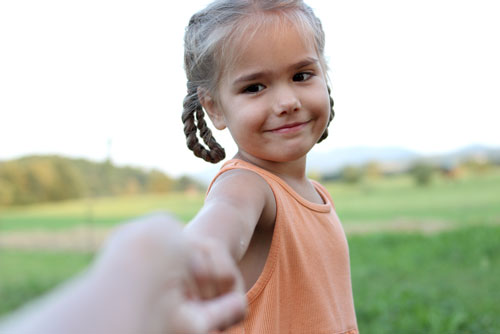
The good news here is that, while the injury may result in some initial pain, there are maneuvers that a physician can perform to easily reset the elbow, thereby restoring movement and alleviating pain.
Nursemaid’s elbow often occurs when an adult or older sibling pulls suddenly on the child’s arm (imagine walking with a wobbly toddler who stumbles while they’re holding your hand) or even while playing (this is one of the reasons you shouldn’t swing a child around while just holding them by their hands or arms). It should be noted that nursemaid’s elbow is rarely caused by falling – if your little one falls directly onto their elbow or onto an outstretched hand, the resulting pain may be due to a broken bone.
This happens so easily with young children (up to age 7 or so) because of the fact that their bones and muscles are still developing and it takes very little force to pull the bones of the elbow partially out of place. The separation occurs because the ligaments (strong tissues that attach bones to each other) in their still maturing little arms aren’t yet fully formed, meaning that even a mild force on the joint can cause it to partially dislocate. The ligament that surrounds the radius (a bone in the forearm) can also be quite loose in some kids, which can lead to multiple bouts of the affliction.
If you’re not familiar with the anatomy of the elbow (which is totally OK…that’s why we’re here!), check out this blog post for an in-depth look at the joint. Here’s a quick summary, as well: The elbow is comprised of the upper arm bone (humerus) as well as the two bones in the forearm (radius and ulna). On both the inner and outer aspects of the elbow there are strong ligaments that hold the joint together. Within the elbow the humeroulnar joint allows for the bending of the elbow, and is between the ulna and humerus; the radiocapitellar joint – which is made up of the radius and a portion of the humerus – is what allows for forearm rotation (turning the hand palm up or palm down). It’s the radiocapitellar joint that is involved in nursemaid’s elbow.
Diagnosing nursemaid’s elbow is frequently based on how the injury occurred as well as the manner in which the child holds the injured arm. X-rays aren’t required to diagnose nursemaid’s elbow, but the treating physician (be it your pediatrician, family physician, emergency room doctor, or orthopaedic surgeon) may order one just to make sure there are no broken bones. Treatment of nursemaid’s elbow involves a medical professional gently moving the bones back into normal position (this is known as “reduction”). Although the child may experience a brief bit of discomfort during the procedure, the pain subsides once the bones are back in the correct position. In fact, most children will start to use the arm within minutes of the procedure, although it may take up to 24 hours for the pain to completely subside and for normal function to be regained.
While it’s true that some children are predisposed to weaker ligaments than others – thereby making them more prone to this particular injury – there are guidelines that parents are caregivers can follow to help prevent nursemaid’s elbow, specifically:
- Never swing a child by holding their hands or arms;
- Do not tug or pull on a child’s hands or arms; and,
- When lifting a child, grasp them gently under the arms – never lift a child by holding their hands or arms.
While nursemaid’s elbow can be scary to experience, know that it’s relatively easy to both treat – and prevent – simply by following a few easy steps.
Source: aaos.org

